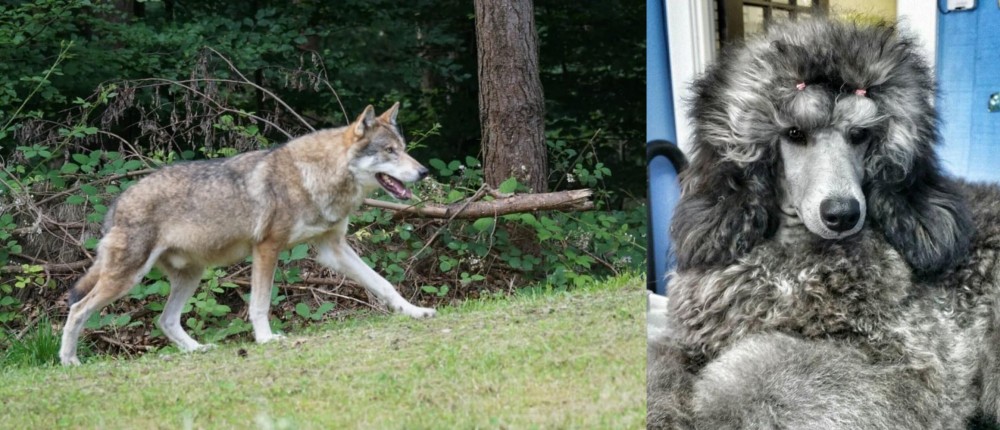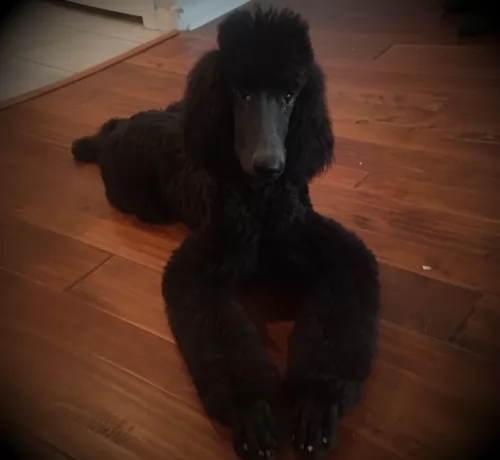 Petzlover
Petzlover Tamaskan is originated from United Kingdom but Standard Poodle is originated from Germany. Tamaskan may grow 31 cm / 13 inches higher than Standard Poodle. Tamaskan may weigh 18 kg / 40 pounds more than Standard Poodle. Both Tamaskan and Standard Poodle has same life span. Both Tamaskan and Standard Poodle has almost same litter size. Tamaskan requires Low Maintenance. But Standard Poodle requires Moderate Maintenance
Tamaskan is originated from United Kingdom but Standard Poodle is originated from Germany. Tamaskan may grow 31 cm / 13 inches higher than Standard Poodle. Tamaskan may weigh 18 kg / 40 pounds more than Standard Poodle. Both Tamaskan and Standard Poodle has same life span. Both Tamaskan and Standard Poodle has almost same litter size. Tamaskan requires Low Maintenance. But Standard Poodle requires Moderate Maintenance
 It is believed that the Tamaskan has been specifically bred to resemble a wolf, and he does too.
It is believed that the Tamaskan has been specifically bred to resemble a wolf, and he does too.
They aren’t recognized by the Federation Cynologique Internationale as they aren’t purebred. In fact they aren’t recognized by any kennel club, being crossbred with other dog breeds such as the German Shepherd, Siberian Husky and Alaskan Malamute.
 The Poodle is the national dog of France, and there they are known as the duck dog. The breed actually originated as a duck hunter in Germany. It was known as ‘Pudelin’ which means splashing in water.
The Poodle is the national dog of France, and there they are known as the duck dog. The breed actually originated as a duck hunter in Germany. It was known as ‘Pudelin’ which means splashing in water.
The dog has always had a crisp, curly coat to protect it from the elements. It is classified as a non-sporting dog. Soon the French became aware of what a fine dog it was and it became sought after among the elite in France.
It has been known for at least 400 years. While it is still not sure precisely from which country it comes, the poodle is a descendant of the French Water Dog which is now extinct.
 The beautiful Tamaskan dog is large, standing at between 61 and 71cm in height and weighing between 23 and 45 kg.
The beautiful Tamaskan dog is large, standing at between 61 and 71cm in height and weighing between 23 and 45 kg.
It is a mix between several sled dogs – Siberian Husky and Alaskan Malamute. The thick double coat is coarse and can be grey, cream, black or reddish and the tail of the Tamaskan is wolf-like too – thick and bushy.
His ears are erect and alert and he has sharp hearing. His almond shaped eyes can be yellow or brown and they are alert and bright and don’t miss a thing.
The Tamaskan is capable of becoming a good family pet, being gentle with children and accepting of other dogs. His high intelligence makes it that he can learn a lot of simple commands.
Because he has been a pack dog, he doesn’t like to be left alone. He is social and as a pet he will want to be an interactive part of his human family. Leaving him unsupervised for days on end will see him getting up to mischief.
He will die of depression, boredom and loneliness if he is put into the back yard and ignored.
They are certainly not recommended for life in the city but will need to have a large space to run and play.
 The Standard Poodle is a medium-sized dog that stands between 35 and 40cm in height and weighs between 20 - 27 kg. The coat of the standard poodle is curly and medium length and it comes in a range of different colors – black, brown, cream, apricot or white.
The Standard Poodle is a medium-sized dog that stands between 35 and 40cm in height and weighs between 20 - 27 kg. The coat of the standard poodle is curly and medium length and it comes in a range of different colors – black, brown, cream, apricot or white.
The ears are medium shaped and floppy and the tail is most times docked to half its length. The muzzle is fairly long and the eyes are brown and alert.
Standard Poodles are full of the joys of living and they are friendly, fun, playful dogs. They love playing games with the children and they make excellent family dogs.
He is quite feisty and stubborn and will require training and socialization. He is smart and is in fact, one of the most trainable of all the dog breeds.
They can adapt to life in the city or the countryside but he will need to be exercised wherever he is. The Standard Poodle isn’t aggressive but he can still make a good watchdog.
 The Tamaskan may look like a wolf but he isn’t aggressive. He’s looks can be to your advantage because intruders think twice before confronting a ‘wolf’.
The Tamaskan may look like a wolf but he isn’t aggressive. He’s looks can be to your advantage because intruders think twice before confronting a ‘wolf’.
Little do they know that this is a loving, loyal dog that makes an excellent playmate for children. They’re social too and want to be with their family a lot of the time.
They’re dogs so devoted to their human family that they can even suffer with separation anxiety.
Give him the love and exercise he craves and you’ll find in him the most awesome canine friend.
 Poodles are clever, easy to train and capable of living well in the city or in the countryside.
Poodles are clever, easy to train and capable of living well in the city or in the countryside.
They’re adaptable dogs too which makes them excellent family pets. They’re active and social so when you bring one into your home, you’re going to know he is there.
He wants to be involved in every aspect of your life, bonding with all members of the family, loving to spend time with each one.
He is an all-rounder and will also be a great watchdog. Loving and loyal, the Standard Poodle is ready to become your ideal pet and companion.
 Your healthy Tamaskan, even though he isn’t prone to common genetic health problems, can get any one of the many dog illnesses there are, although this is highly unlikely.
Your healthy Tamaskan, even though he isn’t prone to common genetic health problems, can get any one of the many dog illnesses there are, although this is highly unlikely.
However without good food, exercise, love and care, he can also be susceptible to parasites, rabies, parvovirus, hip dysplasia, bloat, skin infections and cancer.
 The Standard Poodle doesn’t have many health issues to worry about and he can live to a ripe old age of 15 or so if he is looked after well.
The Standard Poodle doesn’t have many health issues to worry about and he can live to a ripe old age of 15 or so if he is looked after well.
However, he can succumb to some of the common dog diseases there are – eye problems, skin allergies, bloat and ear infections.
Allergies in dogs can be caused by pollen, insects, food, and medicines. These allergies can all cause terrible itching, scratching, watery eyes, skin inflammation, and pain.
The ears, underarms, groin and around the eyes are often affected. It can make your pet most miserable. Your dog will have to get to the vet to relieve him of his discomfort and the vet will want a medical history to find out what is causing the problem.
 The Tamaskan Dog is very active. He just loves activity - long walks and hikes and lots of running off a leash. He’ll love ball games too – anything that keeps him mentally and physically active.
The Tamaskan Dog is very active. He just loves activity - long walks and hikes and lots of running off a leash. He’ll love ball games too – anything that keeps him mentally and physically active.
Provide your beautiful, active Tamaskan dog with top quality food that is rich in protein. You can give him one of the quality commercially manufactured foods – just check out the ingredients on the packaging and go for the dog foods with wholesome, natural ingredients in them.
Your Tamaskan is part of the family and deserves some home-made food. Nothing spicey and exotic as you’ll sit with stomach problems. Boiled chicken, brown rice or pasta and spinach, sweet potatoes and carrots are a super healthy choice and food like this won’t play havoc with your dog’s digestion.
This food can all be chopped up and small portions added into the dry kibble twice a week.
●This is a fairly low maintenance dog. He does shed so a good brush twice a week will be sufficient for him.
●When you brush him, check him over for unusual lumps. Look inside his eyes and inside his mouth as he can’t tell you about a bad tooth that could be causing him pain. Check inside his ears too for signs of redness. If you don’t want to do these things, at least send him to a professional groomer who will do it all for you.
●Have your pet neutered or spayed if you want to avoid puppies. This can be beneficial for your pet’s health too.
 The Standard Poodle will require regular brushing even though it is a low- or non-shedding breed. The curls can become matted. Some poodle owners choose to have their poodles professionally groomed and clipped.
The Standard Poodle will require regular brushing even though it is a low- or non-shedding breed. The curls can become matted. Some poodle owners choose to have their poodles professionally groomed and clipped.
The nails will need to be trimmed.
The teeth will also need to be checked if the dog will allow you to look inside his mouth. A bad, oozing tooth can cause all kinds of medical problems.
Because of the floppy ears, check inside the ears for dirt and wax buildup and signs of redness and a possible ear infection. If you don’t like to probe inside your dog’s ears or mouth, professional dog groomers will do this for you.
Your poodle is an active dog and he will need regular daily exercise. Chase him on the lawn, throw a ball for him, hide away from him and let him find you. He will also love daily walks.
Just like with any other dog, your Standard Poodle needs good, nutritional food to remain healthy. Some of the commercially manufactured dog foods you get are bad for a dog as they don’t have natural ingredients and are devoid of vitamins and minerals.
They’re certainly a convenient way to feed a dog, but try and go for the ones that are wholesome for your pet.
Home-made food such as boiled chicken, brown rice and vegetables is a good choice as it is healthy and won’t cause your dog to battle with digestive problems. Avoid spicy, exotic foods and things such as popcorn, onion, peanuts, and chocolate.
Make sure your Standard Poodle always has a bowl of fresh, cool water available.